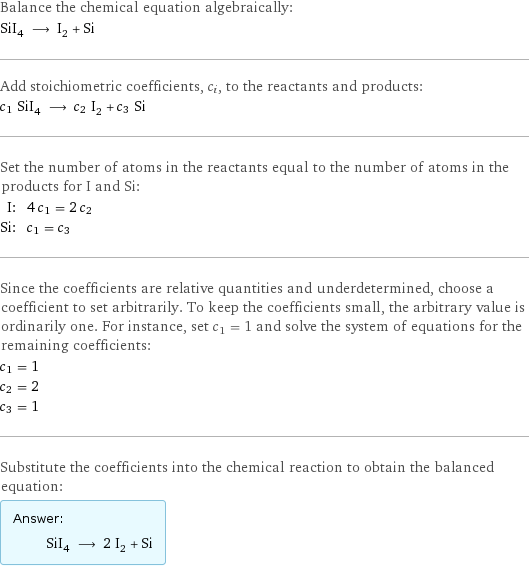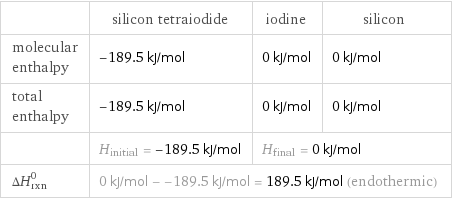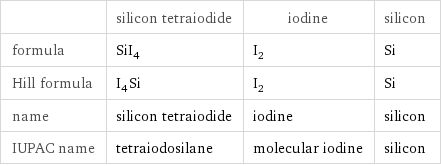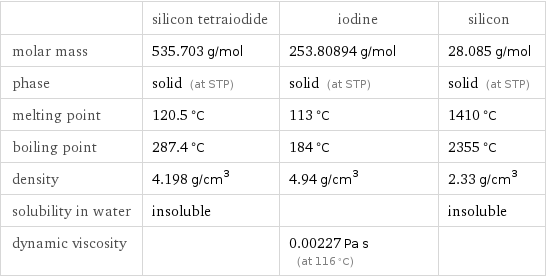Input interpretation

SiI_4 silicon tetraiodide ⟶ I_2 iodine + Si silicon
Balanced equation

Balance the chemical equation algebraically: SiI_4 ⟶ I_2 + Si Add stoichiometric coefficients, c_i, to the reactants and products: c_1 SiI_4 ⟶ c_2 I_2 + c_3 Si Set the number of atoms in the reactants equal to the number of atoms in the products for I and Si: I: | 4 c_1 = 2 c_2 Si: | c_1 = c_3 Since the coefficients are relative quantities and underdetermined, choose a coefficient to set arbitrarily. To keep the coefficients small, the arbitrary value is ordinarily one. For instance, set c_1 = 1 and solve the system of equations for the remaining coefficients: c_1 = 1 c_2 = 2 c_3 = 1 Substitute the coefficients into the chemical reaction to obtain the balanced equation: Answer: | | SiI_4 ⟶ 2 I_2 + Si
Structures

⟶ +
Names

silicon tetraiodide ⟶ iodine + silicon
Reaction thermodynamics
Enthalpy

| silicon tetraiodide | iodine | silicon molecular enthalpy | -189.5 kJ/mol | 0 kJ/mol | 0 kJ/mol total enthalpy | -189.5 kJ/mol | 0 kJ/mol | 0 kJ/mol | H_initial = -189.5 kJ/mol | H_final = 0 kJ/mol | ΔH_rxn^0 | 0 kJ/mol - -189.5 kJ/mol = 189.5 kJ/mol (endothermic) | |
Equilibrium constant
![Construct the equilibrium constant, K, expression for: SiI_4 ⟶ I_2 + Si Plan: • Balance the chemical equation. • Determine the stoichiometric numbers. • Assemble the activity expression for each chemical species. • Use the activity expressions to build the equilibrium constant expression. Write the balanced chemical equation: SiI_4 ⟶ 2 I_2 + Si Assign stoichiometric numbers, ν_i, using the stoichiometric coefficients, c_i, from the balanced chemical equation in the following manner: ν_i = -c_i for reactants and ν_i = c_i for products: chemical species | c_i | ν_i SiI_4 | 1 | -1 I_2 | 2 | 2 Si | 1 | 1 Assemble the activity expressions accounting for the state of matter and ν_i: chemical species | c_i | ν_i | activity expression SiI_4 | 1 | -1 | ([SiI4])^(-1) I_2 | 2 | 2 | ([I2])^2 Si | 1 | 1 | [Si] The equilibrium constant symbol in the concentration basis is: K_c Mulitply the activity expressions to arrive at the K_c expression: Answer: | | K_c = ([SiI4])^(-1) ([I2])^2 [Si] = (([I2])^2 [Si])/([SiI4])](../image_source/f697b34b1e6d8377d1b5086a34f36e79.png)
Construct the equilibrium constant, K, expression for: SiI_4 ⟶ I_2 + Si Plan: • Balance the chemical equation. • Determine the stoichiometric numbers. • Assemble the activity expression for each chemical species. • Use the activity expressions to build the equilibrium constant expression. Write the balanced chemical equation: SiI_4 ⟶ 2 I_2 + Si Assign stoichiometric numbers, ν_i, using the stoichiometric coefficients, c_i, from the balanced chemical equation in the following manner: ν_i = -c_i for reactants and ν_i = c_i for products: chemical species | c_i | ν_i SiI_4 | 1 | -1 I_2 | 2 | 2 Si | 1 | 1 Assemble the activity expressions accounting for the state of matter and ν_i: chemical species | c_i | ν_i | activity expression SiI_4 | 1 | -1 | ([SiI4])^(-1) I_2 | 2 | 2 | ([I2])^2 Si | 1 | 1 | [Si] The equilibrium constant symbol in the concentration basis is: K_c Mulitply the activity expressions to arrive at the K_c expression: Answer: | | K_c = ([SiI4])^(-1) ([I2])^2 [Si] = (([I2])^2 [Si])/([SiI4])
Rate of reaction
![Construct the rate of reaction expression for: SiI_4 ⟶ I_2 + Si Plan: • Balance the chemical equation. • Determine the stoichiometric numbers. • Assemble the rate term for each chemical species. • Write the rate of reaction expression. Write the balanced chemical equation: SiI_4 ⟶ 2 I_2 + Si Assign stoichiometric numbers, ν_i, using the stoichiometric coefficients, c_i, from the balanced chemical equation in the following manner: ν_i = -c_i for reactants and ν_i = c_i for products: chemical species | c_i | ν_i SiI_4 | 1 | -1 I_2 | 2 | 2 Si | 1 | 1 The rate term for each chemical species, B_i, is 1/ν_i(Δ[B_i])/(Δt) where [B_i] is the amount concentration and t is time: chemical species | c_i | ν_i | rate term SiI_4 | 1 | -1 | -(Δ[SiI4])/(Δt) I_2 | 2 | 2 | 1/2 (Δ[I2])/(Δt) Si | 1 | 1 | (Δ[Si])/(Δt) (for infinitesimal rate of change, replace Δ with d) Set the rate terms equal to each other to arrive at the rate expression: Answer: | | rate = -(Δ[SiI4])/(Δt) = 1/2 (Δ[I2])/(Δt) = (Δ[Si])/(Δt) (assuming constant volume and no accumulation of intermediates or side products)](../image_source/12b3e3f7c7c5b18d38a19022a1dc0b3b.png)
Construct the rate of reaction expression for: SiI_4 ⟶ I_2 + Si Plan: • Balance the chemical equation. • Determine the stoichiometric numbers. • Assemble the rate term for each chemical species. • Write the rate of reaction expression. Write the balanced chemical equation: SiI_4 ⟶ 2 I_2 + Si Assign stoichiometric numbers, ν_i, using the stoichiometric coefficients, c_i, from the balanced chemical equation in the following manner: ν_i = -c_i for reactants and ν_i = c_i for products: chemical species | c_i | ν_i SiI_4 | 1 | -1 I_2 | 2 | 2 Si | 1 | 1 The rate term for each chemical species, B_i, is 1/ν_i(Δ[B_i])/(Δt) where [B_i] is the amount concentration and t is time: chemical species | c_i | ν_i | rate term SiI_4 | 1 | -1 | -(Δ[SiI4])/(Δt) I_2 | 2 | 2 | 1/2 (Δ[I2])/(Δt) Si | 1 | 1 | (Δ[Si])/(Δt) (for infinitesimal rate of change, replace Δ with d) Set the rate terms equal to each other to arrive at the rate expression: Answer: | | rate = -(Δ[SiI4])/(Δt) = 1/2 (Δ[I2])/(Δt) = (Δ[Si])/(Δt) (assuming constant volume and no accumulation of intermediates or side products)
Chemical names and formulas

| silicon tetraiodide | iodine | silicon formula | SiI_4 | I_2 | Si Hill formula | I_4Si | I_2 | Si name | silicon tetraiodide | iodine | silicon IUPAC name | tetraiodosilane | molecular iodine | silicon
Substance properties

| silicon tetraiodide | iodine | silicon molar mass | 535.703 g/mol | 253.80894 g/mol | 28.085 g/mol phase | solid (at STP) | solid (at STP) | solid (at STP) melting point | 120.5 °C | 113 °C | 1410 °C boiling point | 287.4 °C | 184 °C | 2355 °C density | 4.198 g/cm^3 | 4.94 g/cm^3 | 2.33 g/cm^3 solubility in water | insoluble | | insoluble dynamic viscosity | | 0.00227 Pa s (at 116 °C) |
Units
